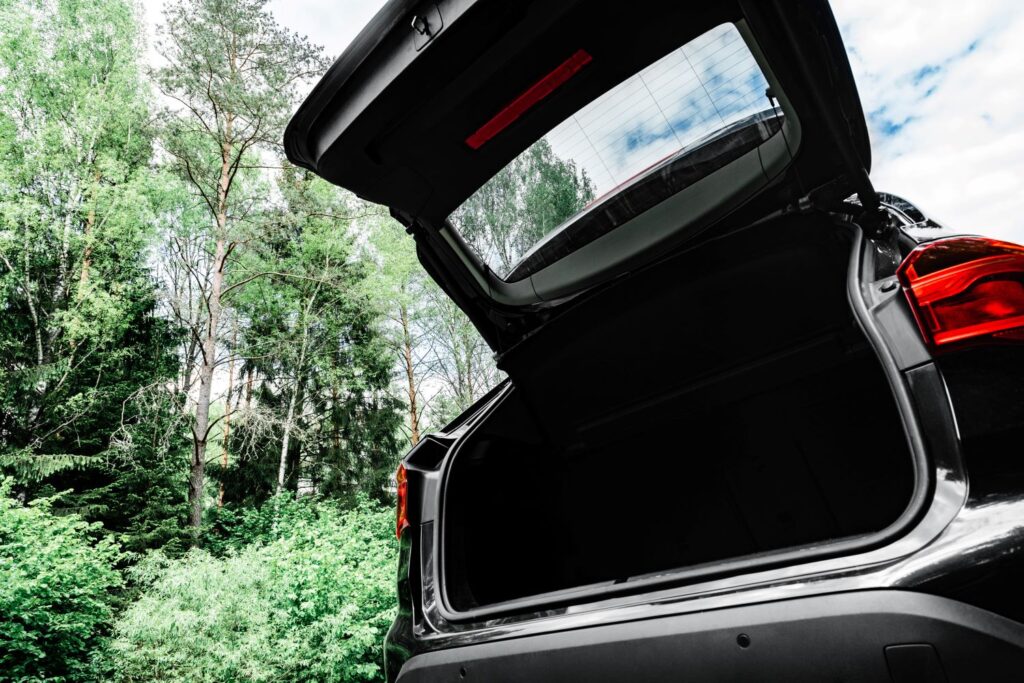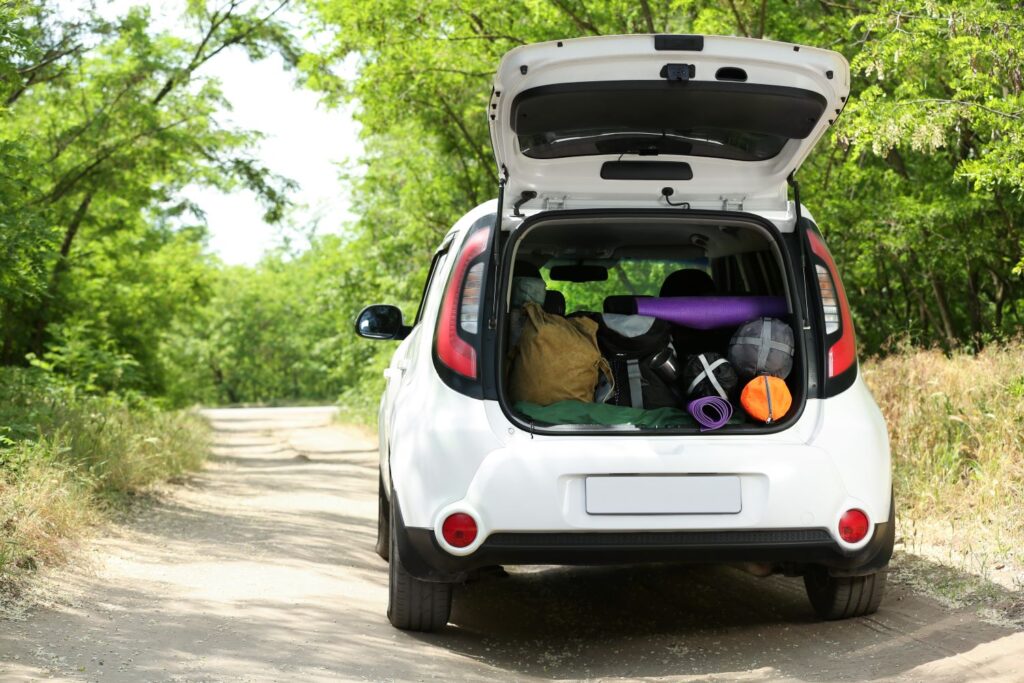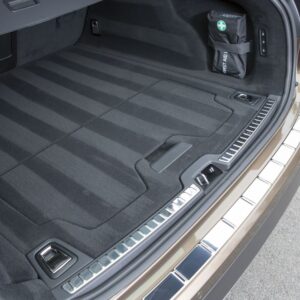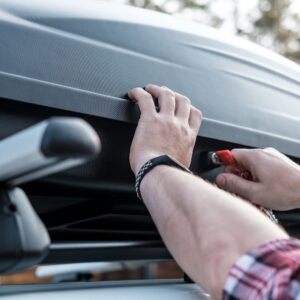Not all pieces of cargo you carry will neatly fit within your vehicle. Sometimes, even the roomiest car trunk, storage space, or truck bed cannot accommodate the oversized item you’re taking home. When you must haul something too big to stay inside the storage, you might have to drive with an open trunk, a partially or fully open hatch door, or the tailgate down.
But is driving with an open trunk legal where you live and work, or will it get you pulled over and issued a ticket by the cops? And if it is allowed, how can you do it safely?
Can You Drive With Your Trunk Open Legally?
The legality of driving your car with trunk open will depend on several factors: They are:
- Vehicle type (car, SUV, truck)
- The presence of cargo in the back
- The size of the cargo
- Federal regulations on rear overhang
- Your home state’s regulations

Driving With An Open Trunk With Bulky Cargo
If you operate a car, truck, or SUV, you can legally drive with the trunk open when transporting bulky cargo like large appliances, construction materials, and furniture that stick out from the back.
However, the cargo must not exceed federal and state limits for rear vehicle overhang. We’ll cover the term overhang in detail later.
Driving With An Open Trunk Without Cargo
Some drivers prefer driving with the trunk lid, hatch door or tailgate open. They habitually do this even when not carrying outsized cargo.
This practice isn’t outlawed in many states. However, Illinois, Kansas, Maryland, Minnesota, Nebraska, New Jersey, and Texas prohibit driving with an open trunk if you’re not transporting bulky cargo that needs extra space.
Rear Overhang Regulations
Overhangs refer to a vehicle’s lengths that protrude from the wheelbase. You have the front overhang for the length extending forward and the rear overhang for the span going out the back.
Opening the hatch door of an SUV or the tailgate of a truck increases the rear overhang of those vehicles. Driving with a longer-than-normal overhang can affect how your car handles. It might also pose a potential danger to other drivers behind your vehicle.
According to federal regulations set by the U.S. Department of Transportation (DOT), vehicles may have overhanging cargo of up to three feet in front, four feet in the back, and four inches on the sides. These overhang limitations are enforceable in all states.
Additionally, each state can enact its standards on permissible overhang limits as long as their limit meets the minimum value set by the DOT. Most states follow federal regulations for the sake of convenience.
Some states allow long overhangs. For example, Arizona, Delaware, and Maryland permit a rear overhang of six feet. Colorado, Nevada, and North Dakota allow 10 feet of rear overhang. Washington has the longest allowed rear overhang. Here, you can drive vehicles with up to 15 feet of overhang.
Many states require vehicle owners to put visible markings that denote their vehicle’s overhangs.
Other states enacted specific regulations for special situations. In Florida, many truck drivers load boats, smaller ground vehicles, or trees on their truck beds. Local lawmakers permitted trucks laden with automobiles and boats to have three feet of front overhang and nine feet of rear overhang. Trucks carrying trees have a permitted rear overhang of up to 10 feet.
When you look up your home state’s regulations on driving with an open trunk, check its permitted rear overhang limitations.
While you’re at it, check how your home state measures overhangs. States like California define the length by the nearest axle. Other states set their overhang limits based on the tip of the closest bumper. If you drive between states, you might find that a legal rear overhang measurement in one becomes illegal when you cross the border.

How to Safely Drive Your Car With Trunk Open
So you’ve done the research. You confirmed that driving with an open trunk, hatch door, or tailgate in your state is legal. You also made sure that the rear overhang meets the maximum length allowed.
Legally driving with an open trunk is one thing. Doing so safely is another thing entirely. Follow these steps to make the trip safe and easy.
Secure the Cargo
Tie down the cargo with ropes, chains, netting, or a combination of those tools. Make sure the object stays in place and doesn’t shift. Even the slightest movement might loosen the tie-downs.
Check the Rear-View Mirror
Once you finish securing the cargo, sit in the driver’s seat but don’t drive off yet. Instead, look into the rear-view mirror and check if you can still see out the back of your car.
Depending on the cargo’s size and how you positioned it, the payload might partially or fully block your view of the road behind you. You might not notice another vehicle coming up behind you.
Position the cargo to stay out of sight as much as possible. If it’s not possible, adjust the rear-view mirror to see more of the road. Remember to use the side mirrors to compensate for the obscured rear-view mirror.

Drive Slowly and Carefully
Patience is crucial when driving with the trunk open. Proceed at a steady pace to minimize your cargo’s movement.
Don’t enter highways that force you to drive and maneuver at high speeds. The ensuing jostling can loosen the tie-downs securing your cargo, increasing the risk of it falling out of the trunk. Instead, look for back roads that see little traffic.
Keep your trip brief. The shorter the distance you have to cover, the less time you have to put up with low visibility.
Drive on Smooth Roads
Plot your trip ahead of time. Plan a route following the best roads with the fewest speed bumps throughout the drive. Minimizing the jolting caused by driving over uneven terrain reduces the risk that the cargo slips out of the open trunk.
If you must navigate a rough road, drive slowly and carefully. Try to avoid the bumpiest patches.
Defensive Driving
If you’re driving with an open trunk, drive defensively. It’s more difficult to spot other vehicles coming up behind you with the raised trunk lid or oversized object blocking your rear view.
At the same time, your cargo can pose a danger to other drivers, especially if it falls out of the trunk. Thus, you must stay alert and monitor the traffic around your car.
Any information provided on this Website is for informational purposes only and is not intended to replace consultation with a professional mechanic. The accuracy and timeliness of the information may change from the time of publication.















